Book contents
- Frontmatter
- Contents
- Acknowledgments
- 1 Introduction: the emergence of a new research field
- 2 The context of the discovery
- 3 Reconfiguring actors and knowledge: the organization of a new research field
- 4 Academic research, science policy, and the industrial connection: setting up national high-temperature superconductivity programs
- 5 Science and the media: newspapers and their “HTS story”
- 6 The innovation machinery of science: the case of HTS
- Appendix 1 Main events in the history of superconductivity before the discovery by Müller and Bednorz
- Appendix 2 Chronology of important events in high-temperature superconductivity in the early phase
- References
- Index
1 - Introduction: the emergence of a new research field
Published online by Cambridge University Press: 02 December 2009
- Frontmatter
- Contents
- Acknowledgments
- 1 Introduction: the emergence of a new research field
- 2 The context of the discovery
- 3 Reconfiguring actors and knowledge: the organization of a new research field
- 4 Academic research, science policy, and the industrial connection: setting up national high-temperature superconductivity programs
- 5 Science and the media: newspapers and their “HTS story”
- 6 The innovation machinery of science: the case of HTS
- Appendix 1 Main events in the history of superconductivity before the discovery by Müller and Bednorz
- Appendix 2 Chronology of important events in high-temperature superconductivity in the early phase
- References
- Index
Summary
Discovered in 1911 at temperatures near absolute zero, superconductivity is the loss of resistance to electrical current some materials display when cooled below a “critical temperature”. The phenomenon was confined to scientific laboratories until the late 1950s, when first technological applications became feasible. It also took nearly half a century before a theoretical explanation of the phenomena – the BCS theory – was formulated. In the following two decades, numerous researchers contributed to the field, but no materials were found with critical temperatures higher than 23 Kelvin (–250° Celsius). By the mid 1980s, the scientific community had reached the consensus that superconductivity was a closed field, and that the dream of room-temperature superconductors should be abandoned.
But the year 1986 changed this situation dramatically. Two researchers at the International Business Machines (IBM) lab near Zurich, Switzerland, discovered a new class of materials among the ceramic oxides that display superconductivity at temperatures far higher than previously observed.
High-temperature superconductivity was born.
A surprising discovery and its consequences
Like a minor earthquake, the discovery of high-temperature superconductivity in late 1986 sent a shock wave through the research systems of the industrialized countries, exciting scientists, policy-makers, and the lay public alike. We followed the course of the discovery, intrigued to observe and analyze what the tremor revealed: which structures of the system of science and research proved robust and resistant, and what gave way, crumbling under the unexpected shake-up?
But above all, we wanted to investigate what researchers, science policymakers, industry, the media – and through them the general public – would make of the event.
- Type
- Chapter
- Information
- After the BreakthroughThe Emergence of High-Temperature Superconductivity as a Research Field, pp. 1 - 13Publisher: Cambridge University PressPrint publication year: 1997



